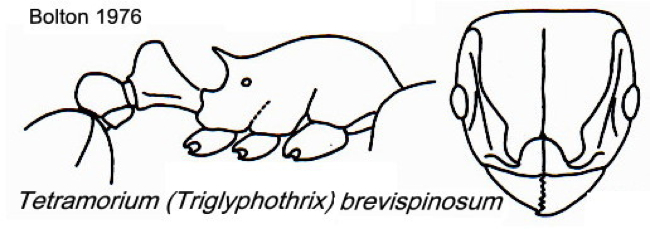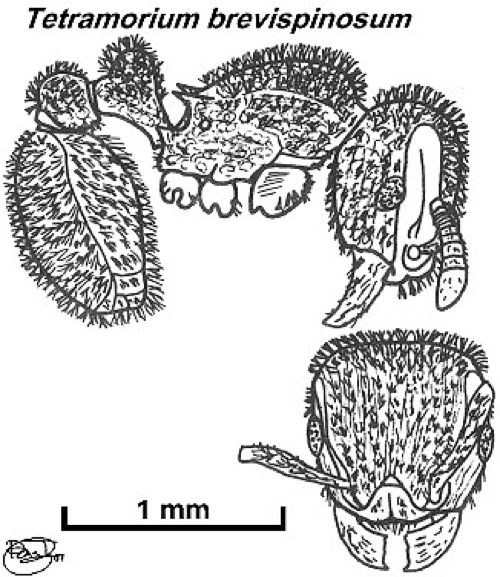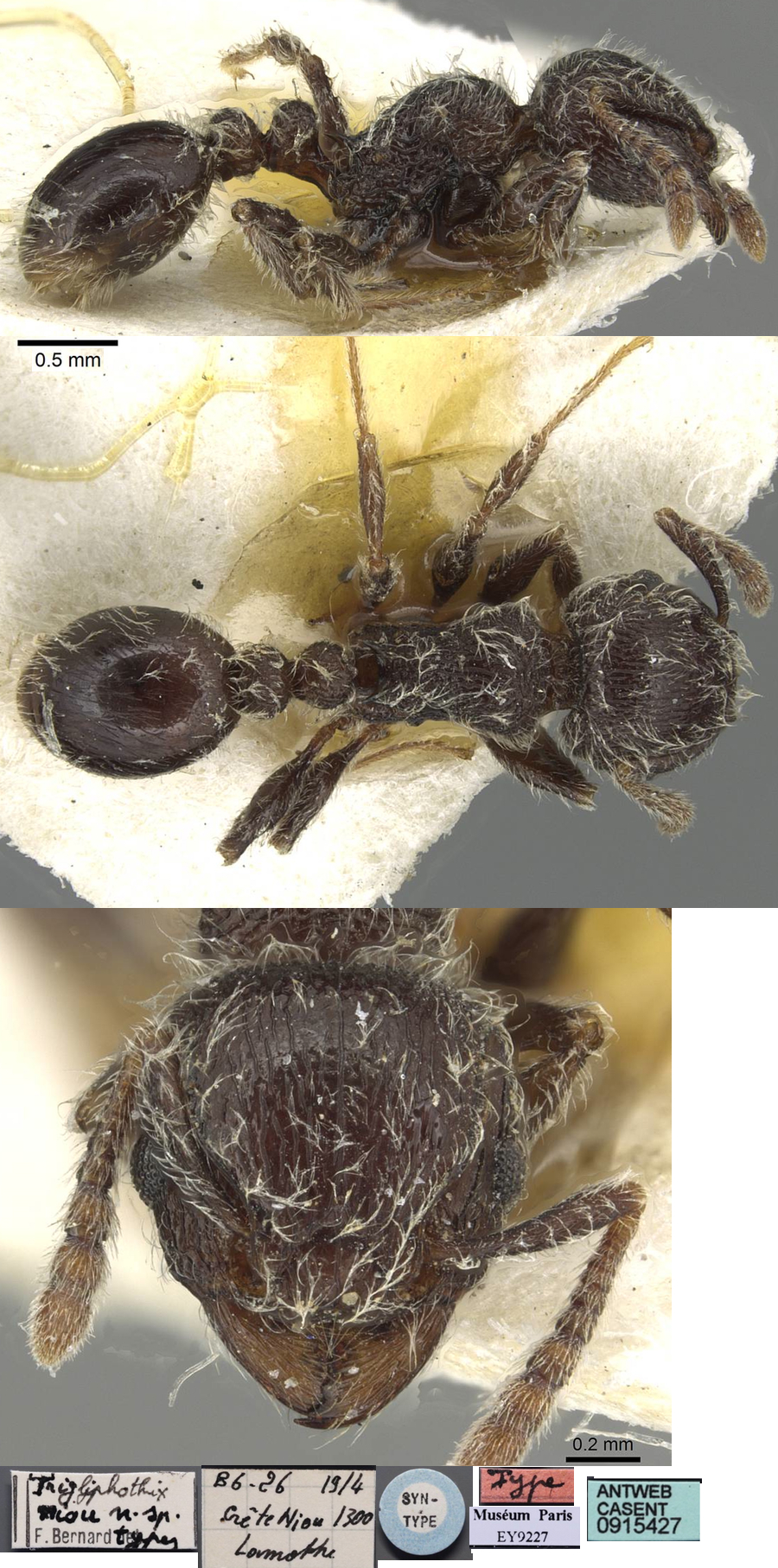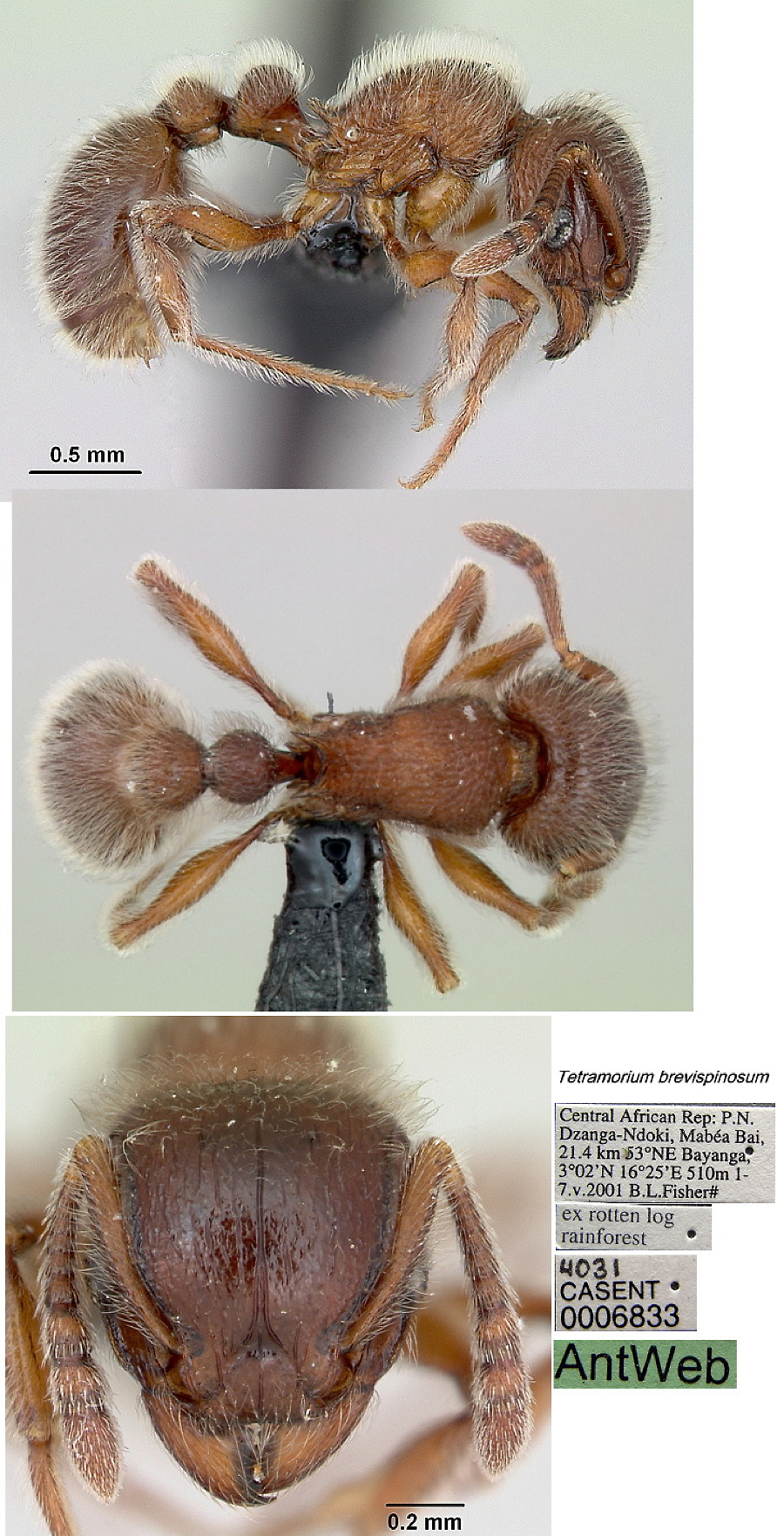Tetramorium brevispinosum (Stitz)
  Type location Togo (Triglyphothrix
gabonensis Andr. v. brevispinosus n. v., Stitz, 1910: 144,
worker) - no images on Antweb (April 2015) Type location Togo (Triglyphothrix
gabonensis Andr. v. brevispinosus n. v., Stitz, 1910: 144,
worker) - no images on Antweb (April 2015)
junior synonym nion (Triglyphothrix
nion n. sp., Bernard, 1952: 248, illustrated)
from Guinea, two workers from Mt. Nimba, at Crête Nion, station
B6.26, 1300 m, collector Lamotte - see below
worker only described (see Bolton,
1995).
The type location in Bolton (1976) was given as Togo, at
Bismarckburg, collected by Conradt; with a lectotype in the Berlin
Museum (which fits the title of the Stitz, 1910, paper - being on West
African ants, see Bolton, 1995, and is the location given by Wheeler,
1922). Bolton (1995) also altered the name from brevispinosa,
in his 1976 paper, where he had changed it from the brevispinosus
of Stitz  . .
|
Stitz's (1910) description is at  . Bernard's (1952) description of nion
is at . Bernard's (1952) description of nion
is at  . Bolton's modern
description (1976, illustrated, full-face view, alitrunk and pedicel
profile) is at . Bolton's modern
description (1976, illustrated, full-face view, alitrunk and pedicel
profile) is at  . .
|
 Bolton (1976)
described it as a widely distributed
forest-inhabiting species, found in both primary forest and more open
woodland. Described as widespread in Ghana (118 workers from 6
sites, as T. brevispinosum), from their leaf litter collections
in the semi-deciduous forest zone, by Belshaw & Bolton (1994b).
Earlier, Bolton (1976) had listed collections at Bunso (D. Leston,
apparently by pkd, indicating the species may climb trees), CRIG (A.H.
Strickland; himself) and Mt. Atewa (himself). Other countries listed by
Bolton (1976) include Ivory Coast, at Banco Forest (W.L.
Brown); and more easterly across to Kenya. Santschi (1935) had
a single finding from Mayumbe, Kai Bumba, Zaïre (as Triglyphothrix
gabonensis var brevispinosa). Bolton (1976)
described it as a widely distributed
forest-inhabiting species, found in both primary forest and more open
woodland. Described as widespread in Ghana (118 workers from 6
sites, as T. brevispinosum), from their leaf litter collections
in the semi-deciduous forest zone, by Belshaw & Bolton (1994b).
Earlier, Bolton (1976) had listed collections at Bunso (D. Leston,
apparently by pkd, indicating the species may climb trees), CRIG (A.H.
Strickland; himself) and Mt. Atewa (himself). Other countries listed by
Bolton (1976) include Ivory Coast, at Banco Forest (W.L.
Brown); and more easterly across to Kenya. Santschi (1935) had
a single finding from Mayumbe, Kai Bumba, Zaïre (as Triglyphothrix
gabonensis var brevispinosa).
|
 Nigeria
specimen (as Triglyphothrix species B, Taylor 1980a: 59)
WORKER. TL 3.52, HL 0.87, HW 0.78, SL 0.57, PW 0.62 Nigeria
specimen (as Triglyphothrix species B, Taylor 1980a: 59)
WORKER. TL 3.52, HL 0.87, HW 0.78, SL 0.57, PW 0.62
Colour red-brown, gaster darker. Head, alitrunk and pedicel
sculpturation of coarse reticulation. Abundant, dense white, trifid
hairs all over, giving the live ants a furry appearance to the naked
eye. Head with well marked antennal scrobes, into which the antenna can
be closed. In profile the alitrunk is convex, with all margins rounded.
Propodeal spines flat, acutely triangular; metapleural lobes short
triangles. Petiole and postpetiole with high domed nodes; there is a
minute subpetiolar denticle.
I found it nesting in hard packed soil and foraging on the ground,
Cocoa Research Institute of Nigeria, Idi Ayunre, plot W3, 6.x.1975.
Listed as from CRIN (B. Bolton, in Bolton, 1976).
|
 The photomontage is a
syntype worker of nion collated from http://www.antweb.org/specimen.do?name=casent0915427. The photomontage is a
syntype worker of nion collated from http://www.antweb.org/specimen.do?name=casent0915427.
|
Oxford University
Museum
specimens
|
 The photomontage is of
a worker from Liberia, Yekepa;
collector E Poiriet (Yekepa PF6) The photomontage is of
a worker from Liberia, Yekepa;
collector E Poiriet (Yekepa PF6)
|
 The photomontage is of
a worker from Ghana,
collected by S Sky Stephens, 2006. The photomontage is of
a worker from Ghana,
collected by S Sky Stephens, 2006.
|
 The
photomontage is
of a worker from Cameroun;
Awae II; collector A Fotso Kuate (fk
tetramorium sp N) The
photomontage is
of a worker from Cameroun;
Awae II; collector A Fotso Kuate (fk
tetramorium sp N)
|
 The
photomontage is
of a worker from Central African
Republic;
Dzanga-Sangha NP; collector P Annoyer (PCO4) The
photomontage is
of a worker from Central African
Republic;
Dzanga-Sangha NP; collector P Annoyer (PCO4)
|
 The photomontage is
collated from http://www.antweb.org/specimen.do?name=casent0006833.
Note - Bolton (1976) remarked how some specimens had the sculpturation
on the face almost effaced so that the cephalic median carina forms the
only distinct marking on the dorsum. The photomontage is
collated from http://www.antweb.org/specimen.do?name=casent0006833.
Note - Bolton (1976) remarked how some specimens had the sculpturation
on the face almost effaced so that the cephalic median carina forms the
only distinct marking on the dorsum.
|
|